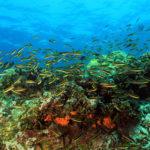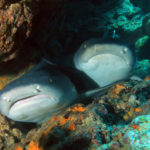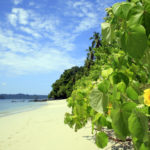Coiba, a rainforest-draped island off the Panama coast, is home to white-sand beaches and waters teeming with marine life. This island was a prison for some of Panama's most notorious criminals until 2004. In 2005, it became a UNESCO World Heritage Site and part of Coiba National Park, which encompasses 38 islands. Scuba diving at Coiba National Park is truly world class.
You can access Coiba via Panama liveaboard diving, which involves visiting Coiba Island itself and exploring the 37 surrounding islands and islets. This area of Panama offers fantastic diving at a variety of sites with sharks, rays, whales, dolphins and more.
When to visit
Panama is hot and humid year-round, with a rainy season from May to November and a dry season from December to April. Diving conditions are excellent all year, though large numbers of humpback whales mate and give birth around Coiba Island from July to October each year.
Water temperature varies from around 81 to 84 F (27 to 29 C) but noticeable thermoclines can plunge the temperature to around 60 F (16 C). Be sure to bring exposure suits to accommodate a wide range of temperatures.
The diving and weather conditions at Panama can be unpredictable and challenging, making this destination best suited to experienced divers. There are, however, some sites suitable for less experienced divers and snorkelers. Here are our picks for the best sites at Coiba Island.




Mona Lisa
This submerged island of rocks is a huge cleaning station, with large schools of butterfly and king angelfish on the southern slope of the dive site. Schools of barracuda, jacks and spadefish visit the stations; divers can see turtles, rays, whitetip sharks and plenty of macro life as well. This site makes for a great night dive to watch hunting whitetip sharks.
The northern slopes reach depths of 46 feet (14 m) and the southern side slopes down to 100 feet (30 m). Dive depths can range from 16 to 60 feet (5 to 18 m) and the site is protected from currents, making it accessible to less-experienced divers.
Hill Rock
Hill Rock is known for unique volcanic landscapes, with large rocks that are home to numerous schools of fish. Divers can see schools of triggerfish, spadefish, barracuda, jacks and snapper. Large nurse sharks and whitetip sharks also visit the site regularly. Maximum dive depth is 72 feet (22 m) and it's best to dive at high tide because of the surge from the south.
Cathedral Rock
This is one of Coiba's most popular dive sites, consisting of two pinnacles that look like the entrance to a cathedral. Corals cover the entire area and the crevices are full of marine life. Hammerheads also visit a local cleaning station. Currents can be fairly strong at this dive site, which starts at 43 feet and descends to around 80 feet (13 to 25 m), making it best for experienced divers.
Jacob's Ladder
This site is very close to some of the park's deepest waters and is exposed to oceanic currents and open ocean swells. White gorgonians cover the pinnacle and the exposed conditions bring in schools of tuna, snapper and barracuda, plus sailfish and marlin. Galapagos and tiger sharks often visit the site as well. The pinnacle begins at 50 feet and drops to 130 feet (16 to 40 m), and the site is suitable for advanced divers only.
The Pyramids
These three pinnacles shaped like pyramids rise out of the depths and are washed by currents that attract all sorts of marine life. The dive site has some of the best hard- and soft-coral diversity in the area, along with plentiful schools of reef fish that attract large predators. Hammerheads and Galapagos sharks are common here.
Maximum depth is around 60 feet (18 m) but the strong currents make this dive site more suitable for experienced divers.
Wahoo
This site off Canales Island inside the park features gentle slopes, descending down to a sandy bottom at 92 feet (28 m). There is plenty of marine life, including frogfish, green morays, jacks, barracuda and spadefish. Divers descending deeper can find eagle rays, manta rays, groupers, green turtles, whitetips and bull sharks. Although this site is exposed to currents, it is still suitable for all experience levels, as well as snorkelers.
Mali Mali
This dive site on Rancheria Island has one of the most colorful reefs in the park. Marine life includes seahorses, mobula rays, whitetip sharks, milkfish, snappers and jacks. It is possible to dive the depths of the reef, though it is ideal for shallow and colorful dives. This site is suitable for all dive experience levels and snorkelers.
By guest authors from liveaboard.com
Divers and writers at LiveAboard.com contributed this article.
The post Scuba Diving at Coiba National Park appeared first on Scuba Diver Life.
from Scuba Diver Life https://ift.tt/2OxKAkX
No comments:
Post a Comment